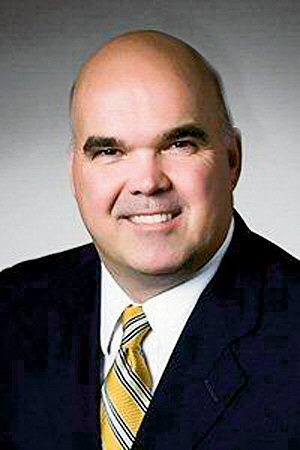
-Marlin Bollinger, CFP, CLU, ChFC, CFS, CAS
President
The Bollinger Group
Benefits Feature
OPPORTUNITIES OUTSIDE THE P-C BOX
Building A Judicious Strategy For Financial Services, Employee Benefits
By Thomas A. McCoy, CLU
When property/casualty agency owners consider ways to broaden their income stream, they might lean toward selling financial services-life, disability and annuities-or they might decide to offer employee benefits. In either case, they are betting their most important asset, their P-C customer relationships, on a potential payoff in a field outside of their traditional expertise. It's a bet they don't want to lose.
So it makes sense to seek guidance from experienced providers of these ancillary products who are used to working with property/casualty brokers. We talked with executives of two such providers-first, a financial services marketing intermediary and, second, a leading voluntary employee benefits company-about how P-C agencies can effectively diversify into these areas.

|
| "P-C brokers have the data to market [financial services products] effectively to their clientele. The opportunity for cross marketing of financial services has never been greater."
-Marlin Bollinger, CFP, CLU, ChFC, CFS, CAS |
Marlin Bollinger, CFP, CLU, ChFC, CFS, CAS, is president of The Bollinger Group, a brokerage general agency for financial services products serving some 200-300 independent brokers, including P-C firms, throughout the United States. The firm represents approximately 30 companies for life, disability, annuities, long-term care and related linked products.
"Property/casualty agents are busy enough in their own areas of specialization, so it's difficult for them to execute a financial services strategy," Marlin says. "They want to do it. They realize that financial services distribution is shifting. The average independent life agent is in their late 50s or early 60s, and new ones just aren't coming into the business. New production is coming from banks and brokerage firms. Yet P-C brokers have the data to market effectively to their clientele. So the opportunity for cross marketing of financial services has never been greater."
To help P-C agencies penetrate this market, Marlin says his firm "takes a consultative, hands-on approach" to help P-C agents generate sales of financial services products to their commercial lines and personal lines clients. The idea is to tailor the marketing assistance to the individual agency's need.
"We have several different modules that can be customized and implemented within an agency. We upload their database, build email marketing programs, and generate leads. Then, based upon the agency's ability to follow up on those leads, they can handle the sales call internally or we can recommend someone to accompany them to the client."
One of the Bollinger Group tools being utilized by P-C firms is a customized email marketing program. "We upload their database into ours, which enables us to send emails with their logo so it looks like the emails are coming directly from the agency," Marlin explains.
Bollinger also provides retail agencies with quoting and placement assistance. For life coverages, the firm offers a multi-carrier quoting and short form entry portal called Drop Ticket, which enables agents to quickly place an order without handling application processing details.
Marlin developed the foundation for his company's expertise in agency marketing during the early 1980s when he worked for Travelers Financial Services, providing point of sale support to property/casualty agents. He became Senior Life Sales Vice President for Travelers Life and Annuity.
"We would help P-C agents identify prospects for financial services products within their client lists. Then we would accompany them on sales calls to these prospects and help make the sale," he says. When he started his own firm in 2003, he was able to utilize the framework of that program, continually updating it with current tools.
Marlin observes changes taking place today in the market for three financial products: disability, long-term care and annuities. "Going back to the 1970s, we've always been aware that disability is vastly undersold. That never seems to change. However, in the last year we've seen a somewhat exponential growth in requests for disability quotes.
"The long-term care market has changed dramatically because the stand-alone, long-term care products are not the go-to products these days. Most companies have pulled out of that area. Only a few are remaining, and we're seeing a shift to asset-based long-term care-long-term care riders on life insurance policies and annuities.
"We've seen substantial growth in our annuity business," Marlin says. "The annuity market is constantly evolving with the introduction of new products. The most popular products are those that offer income riders that guarantee lifetime income. That's because the biggest concern among retirees today is outliving their assets. What's interesting is that their popularity is concentrated in the middle marketplace. The average sale is around $80,000 per annuity."

|
| "A lot of property/casualty firms are recognizing that when the worksite benefits product is included, it has a positive effect on their workers comp claims." -Drew Niziak |
He explains that a P-C agency that wants to offer annuities to its clients could upload its database to Bollinger, or work with them in some modified way. Then a mailing would go to those clients likely to be interested, and a follow-up scheduled.
"The educational material we would provide is sent out through their agency, discussing the need, some of the products and how they work. We present the information in a low-key and professional manner, and discuss products in a generic and general way."
Option #2: Employee benefits
Some property/casualty agents prefer to diversify their income stream by developing an employee benefits practice. Selling to employer groups, rather than individuals, is more in keeping with their focus on commercial accounts. The relationships they have built with decision makers at their commercial customers-owners, HR executives and others-give them access to information about these clients' workplace management objectives and budgets. Above all, these are business relationships based on trust.
The employee benefits business has undergone many changes since the financial crisis of 2008 and the enactment of the Affordable Care Act. One constant has been strong growth in voluntary benefits, which has created opportunities for brokers.
"Ten years ago, 34% of worksite products were sold through brokers; now, according to a Towers Watson study, it's up to about 57%," says Drew Niziak, senior vice president, broker sales and Aflac Benefits Solutions at Aflac. "The brokers understand the need, employers understand the need, and employees are looking for these kinds of benefits. They realize they have gaps. According to the 2015 Aflac WorkForces Report, 52% of employees surveyed have less than $1,000 in savings to cover out-of-pocket expenses associated with an unexpected serious illness or accident. Any significant expense can wipe out their savings."
One way Aflac supports the increasing number of brokers selling voluntary is to give them a significant say in how the enrollment process is conducted. "Some brokers want to use our field organization to conduct face-to-face enrollments. We can also do the enrollments online, utilize enrollment firms or our own proprietary tool."
No matter how the enrollment is conducted, Niziak says, "We like to position the supplemental product right behind the employer's medical product. The enrollee sees both, and can view the regular medical coverage and the supplemental coverages chosen as a package." Alternatively, he notes, "If you put the supplemental coverage down at the bottom (away from where the regular medical benefits are listed), the enrollee may not see the gap in protection, and doesn't check it off."
Aflac's enrollment strategy tracks with its emphasis on educating buyers about risk. It wants to move buyers away from thinking about its supplemental products-which include accident, cancer, critical illness, life, hospitalization, short-term disability, dental and vision-as extras. They can be key tools for managing the employee's total risks, especially at a time when employers are shifting medical costs to employees.
Any property/casualty agent who has emphasized to clients the importance of prioritizing high liability limits, even if it means utilizing higher deductibles elsewhere, can appreciate Aflac's risk management approach. A 2015 Aflac White Paper ("Where does the risk exist?") puts it this way:
"A traditional employee benefit pyramid relies on perceived needs, not financial risks. For example, ancillary benefits like dental and vision are common parts of an employee benefit package. The plans offer low premiums, which make them attractive, but they do much less (than a critical illness policy, for example) to help protect someone from financial ruin."
The White Paper notes that only 30% of companies offer critical illness, while 95% offer dental and 83% offer vision.
Property/casualty agents looking at employee benefits as a means of diversifying their income stream might wonder whether the market has become too daunting because of the continual rise in medical premiums and the enactment of the Affordable Care Act. Niziak has some encouraging observations.
"When the Affordable Care Act was first introduced, there were a lot of brokers who thought they would be out of business, that they would leave the industry. Then brokers began to see that having these other (voluntary) products has benefitted them; it's benefitted their employers and employees.
"With our critical illness product, for example, we had a situation where an employer put in a high deductible health plan. They were nervous about their employees' reaction, so they talked to their broker, who said they should add some worksite products. That mitigated the risk for the employees and it also provided some revenue for the broker. So everybody won."
Niziak sees other reasons for P-C agents to be enthusiastic about offering voluntary benefits products. "A lot of property/casualty firms are recognizing that when the worksite product is included, it has a positive effect on their workers comp claims."
Also, he points out that property/casualty firms with a benefits practice are closely coordinating their property/casualty and benefits presentations to employers. "We see more and more situations where they are going into their clients and saying, 'We have a comprehensive solution for you and your employees.'"
And in the long run, the benefits program helps the employer retain employees, Niziak emphasizes. "According to one of our surveys, 59% of employees said they would accept a job for less pay if they have better benefits, and 45% of employees would stay with their current employer if they just had improved benefits."
The author
Thomas A. McCoy, CLU, retired in 2013 as editor-in-chief of Rough Notes magazine.